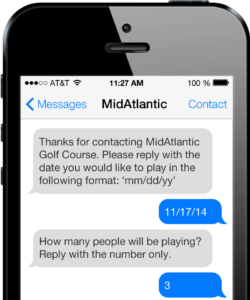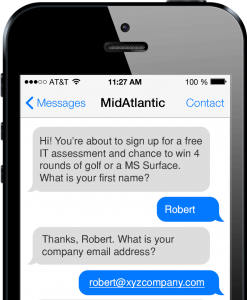
post
July 1, 2015
Business Texting Etiquette: 6 Tips for Writing Great Texts to Customers
This post was co-written with Leslie O’Flahavan of E-Write.
Text messaging isn’t just for pushing parking meter reminders or announcing severe weather. Ahead-of-the-curve companies are using text for two-way communication with customers. At a Denver coffee shop, customers can place their orders and pay by text. A large Midwestern university uses a text messaging service to solicit data from people participating in a long-term study on smoking. A technology company enables customers to troubleshoot software problems via text messaging. Members of a trade association can text their questions about membership levels, how to reset their passwords, and more.
While it may be true that almost anyone can write a text – Just left work. I’ll B home by 6:30 – companies that exchange texts with customers must write great texts: clear, readable, and worthwhile. Follow these business texting etiquette tips, and your company will be able to deliver a great customer experience in under 160 characters.
Texting Etiquette Rule #1
Give clear instructions about what the customer should text to you. Texting a business should be more than just easy; it should be efficient. To make a short, rapid exchange with a customer work, your texts should tell the customer exactly what to do next, what kind of information to supply, and how to supply it.
Here’s an example of a text exchange that tells the customer exactly what to do to book a tee time at a local golf course:
Here’s why these text instructions work:
Consistent terminology. The texts use the word reply each time. There’s no switching back and forth between reply, respond, or send, etc. The consistent wording makes the experience predictable for the customer.
Limited options. The texts ask the customer to do one of two things, such as reply Y or N. Sometimes the texts ask the customer to do just one thing – simpler yet.
Texting Etiquette Rule #2
Use a polite, friendly, upbeat tone. The tone of the texts we exchange with friends and family can be silly, sarcastic, angry, even sexy. But, with business etiquette in mind, the texts companies write to customers should have a business-appropriate tone as well as a text-appropriate tone.
Finding this tone balance isn’t always easy. A business-appropriate tone may sound too stuffy in a text. For example, no one would text a customer “As per our recent conversation…” And a text-appropriate tone may sound unprofessional. No business would use text abbreviations and text a customer “Whazzup? Sry yr order is late…”
So how should companies find the right tone balance? Their texts should be polite and upbeat. Energetic texts that have a let’s-get-things-done tone connect well with customers. For example, here are company’s text request for customers to complete a satisfaction survey, plus two follow-up texts.
Please reply 1-10 to show how likely you would be to recommend our business to someone you know.
[for low scores] Sorry to hear that we haven’t provided the level of support you deserve. Please tell us how we can improve to serve you better in the future.
[for high scores] Thanks for the great rating! We’d love to have you rate us on www.Yelp.com.
What’s polite and upbeat about the tone of these texts?
They use courteous language without sounding stiff: “Sorry to hear…” and “Please tell us…”
The writing conveys energy: “Thanks for the great rating! We’d love to have you…”
The personal pronouns help the company connect. The texts use our, you, we, us, which helps the writing sound friendly.
Texting Etiquette Rule #3
Use correct spelling and punctuation. This might seem like a no-brainer, but some people do think text messaging is casual enough to be beyond spellcheck or correct commas. It’s not. When you’re texting for business, your texts should be spelled and punctuated correctly. Full sentences end with a period; possessives have an apostrophe.
Using correct spelling and punctuation is just the right thing to do. To prove the point, here’s how unprofessional it looks when text messages have errors:
Thanks for your participation – you’ve got a chance to win some great prizes! To begin please reply with you’re first and last name now.
K, thanks! Please reply with the number assigned to the company you’s lie to vote for. A list of company numbers can be found at https://tinyurl.com
Texting Etiquette Rule #4
Establish a statement/question pattern. Patterns help busy readers, so they’re essential when you’re sending a series of text messages. In this series, the company presents the statement first and the question second. The pattern makes the text series easier to read.
Texting Etiquette Rule #5
Strictly limit textese (or don’t use it at all). If you’re sending customers transactional texts (ones that help them get things done) or customer service texts (ones that answer their questions, fix their problems or acknowledge their opinions), you should avoid textese. That’s right. No text abbreviations: no GR8, no LOL, no ATM, no TY.
The only time text abbreviations might work in a text between customers and companies is when the company’s marketing has used it already. So, if your product’s tag line is “Being GR8 4 U,” you will be using text abbreviations. But if your advertising doesn’t include text abbreviations, you should probably skip it.
Texting Etiquette Rule #6
Split long texts into two parts. Respect the 160-character limit for each text. Don’t try to squeeze in more information than the text will hold or load your text with abbreviations so it will fit the character limit. If you have more to say, split a long text into two smaller ones. Make sure each text makes sense on its own.
Here’s one crowded text that should be split into two:
SchoolVIEW site licenses,15-30 users, 6mo license=$399, 12mo=$999. License opts www.SchoolVIEW.com/compare.Click Cust Licenses at top of pg & we’ll send quote.
Here’s the two-text version:
We offer SchoolVIEW site licenses for up to 15 or 30 users. You can choose a 6-month license for $399 or a 12-month for $999.
Compare our SchoolVIEW site license options at www.SchoolVIEW.com/compare. Or click “Custom Licenses” at the top of the page and we’ll prepare a quote for you.
The risks with text are low, and the rewards are high. If you’re writing high-quality, professional, easy-to-read text that meets these business texting etiquette rules, you’re doing text right!
To learn more about business texting etiquette and best practices, download our whitepaper here.
Photo by Flickr user Garry Knight.
Stay up to date
Latest Articles






